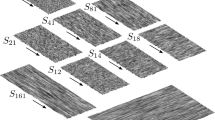Abstract.
The departure from isotropy of turbulent boundary layers over a smooth and a rough wall is presented. The experimental data are analyzed using an anisotropic invariant map. It is shown that the k-type roughness is characterized by a reduced anisotropy of the Reynolds stress tensor. Moreover, the approximation of the diffusive transport of u and v developed in the Hanjalic–Launder numerical model is compared with the experimental results over a smooth and a rough wall. Diffusive transport of u and v is modeled more accurately in the case of the rough surface than in the case of the smooth surface, which can be attributed to the more isotropic behavior of the Reynolds stress tensor for the structures in the rough-wall layer.
Similar content being viewed by others
Author information
Authors and Affiliations
Additional information
Electronic Publication
Rights and permissions
About this article
Cite this article
Keirsbulck, .L., Labraga, .L., Mazouz, .A. et al. Influence of surface roughness on anisotropy in a turbulent boundary layer flow. Exp Fluids 33, 497–499 (2002). https://doi.org/10.1007/s00348-002-0424-9
Received:
Accepted:
Issue Date:
DOI: https://doi.org/10.1007/s00348-002-0424-9




